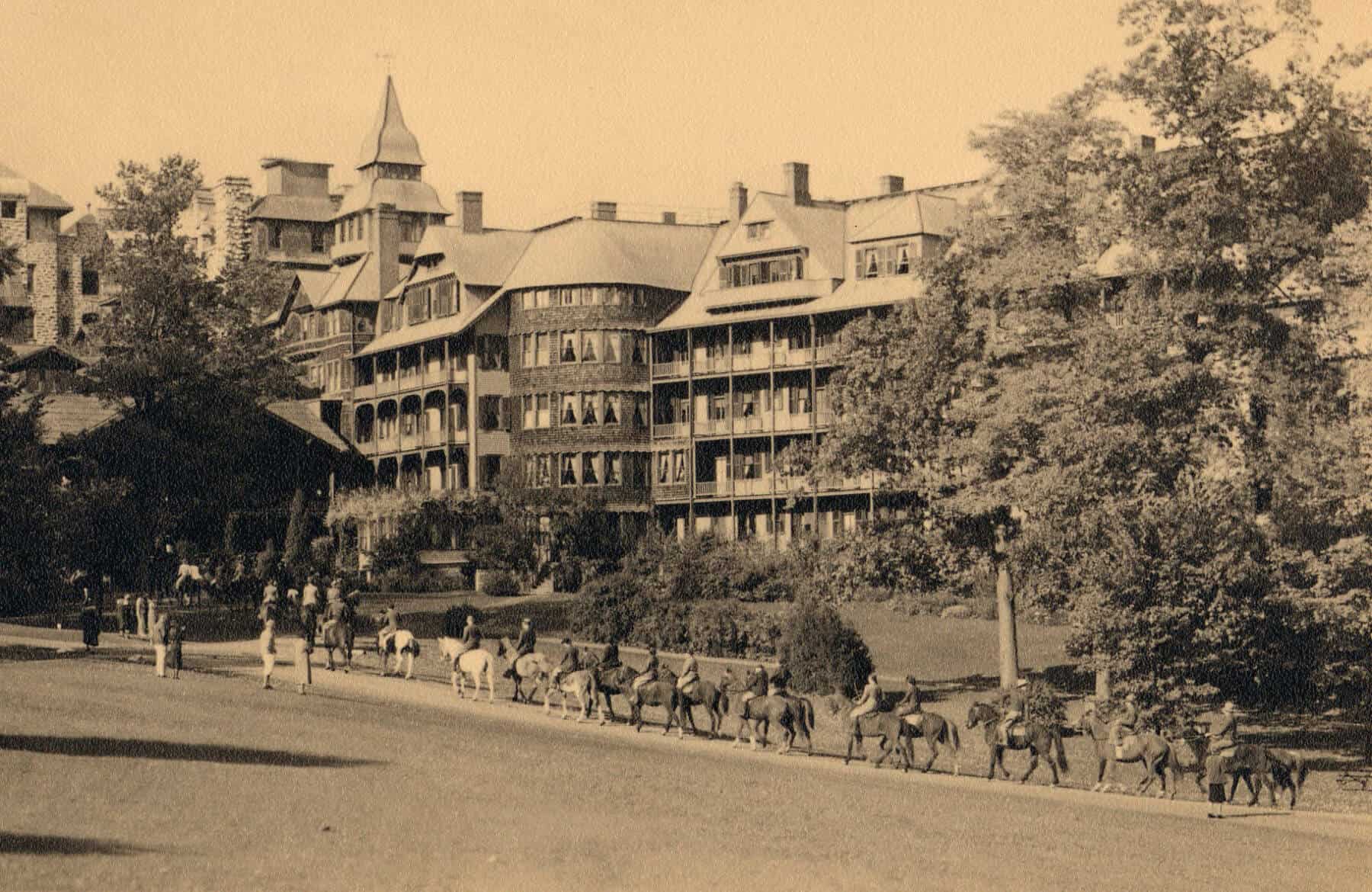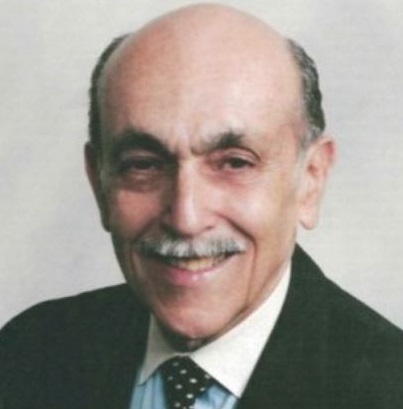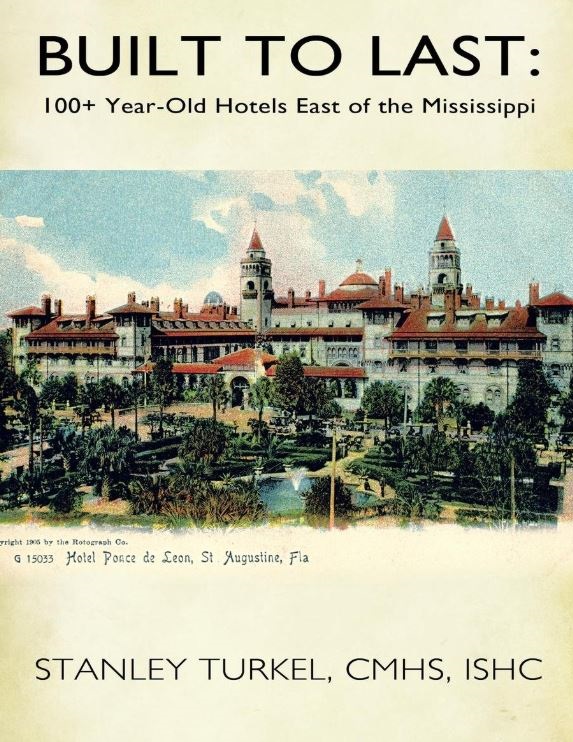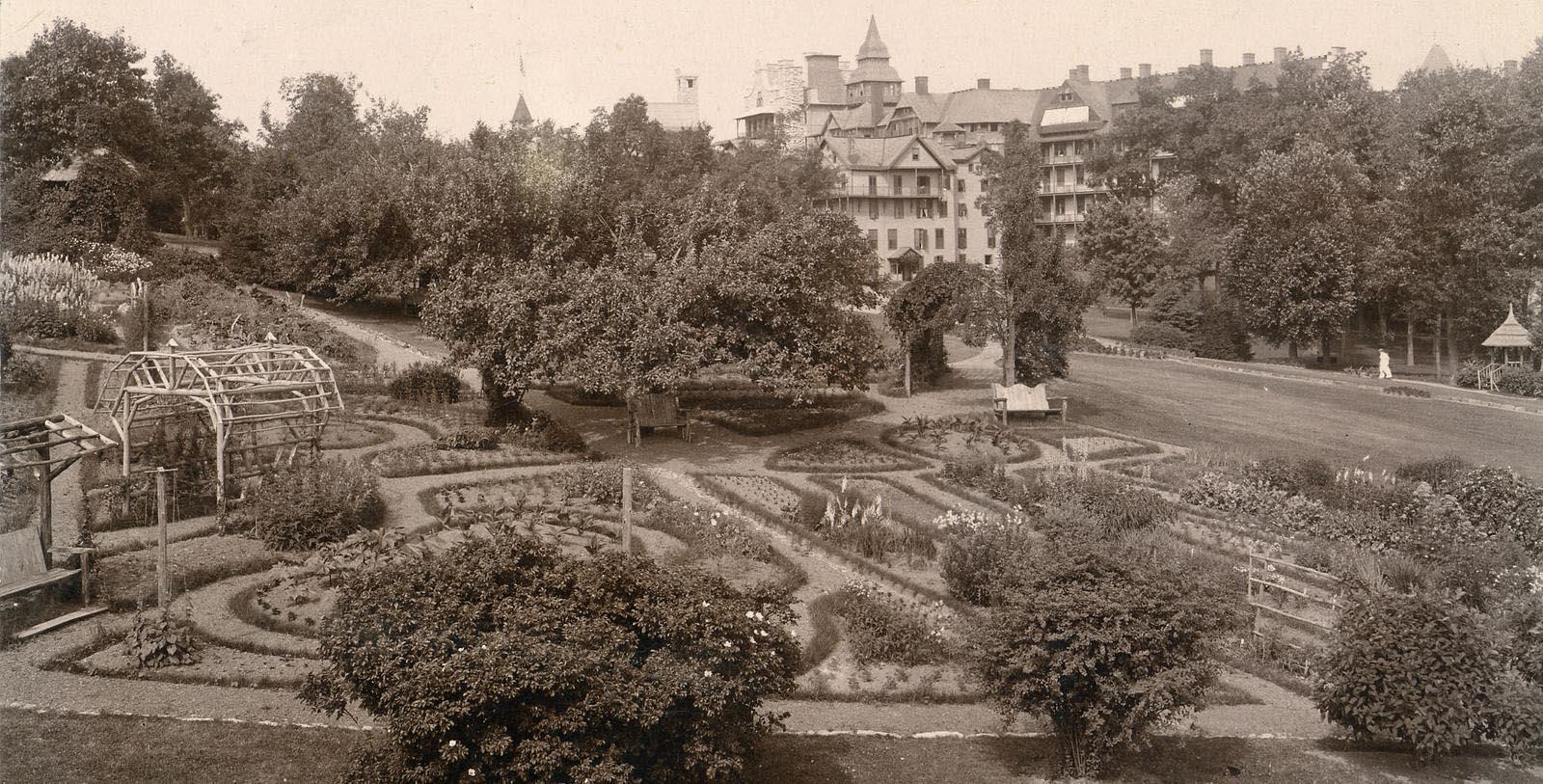Receive for Free - Discover & Explore eNewsletter monthly with advance notice of special offers, packages, and insider savings from 10% - 30% off Best Available Rates at selected hotels.
historic hotel in new york
Discover the Mohonk Mountain House, set on 1,200 acres, it is a Victorian castle with fanciful turrets, local stone, and gabled frame constructions.
Mohonk Mountain House, a member of Historic Hotels of America since 1991, dates back to 1869.
VIEW TIMELINE
Mohonk Mountain House - The Accidental Hotelier
Watch Mohonk Mountain House's Peter Bidowski talk anout the founding of the resort more than a century ago by the Smiley family. He'll also share some remarkable facts about the earliest days of this fabulous historic destination.
WATCH NOWMohonk Mountain House was constructed at a time when the United States was defined by great economic prosperity, industrial expansion, and significant social reform. Much as one sees Lake Mohonk today, Alfred H. Smiley saw it in 1869 when he visited the Shawangunks on a picnic outing. He and his twin brother Albert envisioned a peaceful retreat where people could enjoy the beauty of nature in a truly spectacular setting. Albert purchased the property from John F. Stokes and the brothers eventually turned the ten-room inn and tavern into the grand house it is today, with gracious accommodations for up to 500 guests. People from all walks of life have been attracted to Mohonk, including naturalist John Burroughs, religious leaders Abdul Baha Abbas, Rabbi Louis Finkelstein, and Reverend Ralph W. Sockman, industrialist Andrew Carnegie and four Presidents: Theodore Roosevelt, William Howard Taft, Rutherford B. Hayes, and Chester A. Arthur. Stewardship, reflection, and renewal have been hallmarks of this historic New York hotel since its earliest days. At the turn of the 19th century, the Smiley family hosted the Lake Mohonk Conference of Friends of the Indian and the Lake Mohonk Conference on International Arbitration.
Daniel and Effie Smiley guided Mohonk into the 20th century. The stewardship of the Smiley family, including members who founded Mohonk Mountain House and those who continue to maintain it, received exceptional recognition on December 9, 1986, when Mohonk was officially named a National Historic Landmark. This distinction encompassed not only the Mountain House, but also 83 other Mohonk buildings of historic significance and the surrounding 7,800 acres of developed and undeveloped land. In 1994, the Smiley family and Mountain House staff received an award from the United Nations Environment Programme in honor of "125 years of stewardship" on the occasion of the 125th anniversary of Mohonk Mountain House. Through its buildings and roads, its land, and its spirit, Mohonk exemplifies America’s history and culture. Mohonk has since managed to maintain its 19th century character into the 21st century. Still run by the Smiley family, Mohonk Mountain House is an unspoiled resort, offering classical music concerts and Afternoon Tea and Cookies. The walking trails are off-limits to motor vehicles, and signs along the entrance road read: "Slowly and Quietly, Please." Apt advice for such a scenic retreat.
-
About the Location +
Mohonk Mountain House is located within the Shawangunk Mountains, which many consider to be among the most tranquil destinations in all New York. When Albert K. Smiley first purchased the land surrounding the Mohonk Mountain House, he set about developing an intricate system of hiking trails and carriage roads that many others could enjoy. Now extending for some 85 miles, these scenic pathways are still in use today. They guide guests throughout the grounds to such renowned locations as Copes Lookout and Eagle Cliff Road. But Smiley and his talented teams of landscape architects also set about crafting a series of brilliant English-style gardens that were popular throughout the industrialized world during the mid-19th century. Albert K. Smiley and his family maintained a diligent belief in the splendor of nature, which led to the acquisition of thousands of acres of the surrounding countryside. Ardent conservationists, the Smileys yearned to preserve the area for many future generations to appreciate. The Smileys had acquired so much land that they established the Mohonk Trust during the 1960s, later evolving into the current Mohonk Preserve. Because of the Smileys, Mohonk Mountain House now has access to over 8,000 acres of preserved land, of which 1,200 is directly affiliated with the hotel. The Mohonk Preserve features several breathtaking outdoor attractions, such as the Labyrinth and its famous Lemon Squeeze. The Labyrinth is one of many popular rock scrambles that visitors have adored since the hotel’s earliest days. For over a century, guests have scaled the faces of these geological formations, creating a rich heritage that persists well into the present. The local countryside is home to Lake Mohonk, too, which is a glacier lake that has been fed directly by rainwater for millennia. It extends for nearly a half-mile in length and measures 61 feet at its deepest point. All sorts of trout reside within this majestic body of water, like perch, bass, and pickerel. More than 125 luxurious summerhouses even line the shoreline, with most featuring rich connections to the region’s greater Gilded Age history.
-
About the Architecture +
There is no single architectural style reflected in the sections of the Mohonk Mountain House. When looking at the building from north to south, those segments are as follows: the Spa Wing, the Rock Section, the Stone Building, the Central Building (including the Lake Lounge and the Parlor), the Grove Lodge, and the Dining Wing. All of these structures feature an eclectic mixture of design aesthetics that achieve a magical appearance unrivaled throughout the rest of the country. The architectural story behind Mohonk Mountain House starts with Albert K. Smiley’s initial trip to the area in the middle of 1869. The young Quaker schoolmaster had been implored by his younger brother, Alfred, to travel west from their native Rhode Island to experience the region’s untouched serenity. Once Albert gazed upon the inherent beauty of Lake Mohonk atop Paltz Point, he knew that he needed to develop the location into the site of a wonderful summer retreat.
Albert K. Smiley soon purchased a nearby building known as the Stokes Tavern (and its surrounding land) with $28,000, of which half came from a bank loan. Originally only consisting of ten rooms, Smiley began to gradually expand upon the structure exponentially. Within a matter of decades, the structure boasted 300 lavish rooms, outfitted with the finest Victorian-era furniture and décor. By 1893, he had also added on the current Dining Wing, which was then followed by the Central Building some four years later. The final series of initial renovations concluded in 1910, when Albert developed the Dining Room Circle extension. It was not until 1990 that the Mohonk Mountain House experienced another extensive renovation project. The Smiley family—then in its fourth generation of ownership—constructed the luxurious Conference House that year. The open-air Pavilion followed a decade later in 2001, as well as the award-winning Spa Wing with its swimming pool and fitness level. The most recent addition to the Mohonk Mountain House was the Grove Lodge, opening for the first time in 2016.
-
Famous Historic Events +
Lake Mohonk Conference on International Arbitration (1895 – 1916). Albert K. Smiley himself organized the very first meeting, which sought to build global support for international arbitration as well as an international court to preside over these treaties. Originally attended by individuals hand-selected by Smiley, the conferences soon attracted close to 300 people by the outbreak of World War I. These events proved integral in establishing the eventual Permanent Court of Arbitration, which resides in The Hague, Netherlands.
-
Famous Historic Guests +
John Burroughs, renowned American naturalist active in the U.S. Conservation Movement.
John D. Rockefeller, founder of Standard Oil Company
Andrew Carnegie, founder of U.S. Steel
Thomas Mann, renowned German author and recipient of the 1929 Nobel Prize in Literature
Abdul Baha Abbas, famed Baháʼí religious figure active from 1892 to 1921.
Rabbi Louis Finkelstein, leader of the Jewish Theological Seminary of America
Reverend Ralph W. Sockman, featured speaker on NBC’s National Radio Pulpit from 1928 to 1962.
Rutherford B. Hayes, 19th President of the United States (1877 – 1881)
Chester A. Arthur, 21st President of the United States (1881 – 1885)
Theodore Roosevelt, 26th President of the United States (1901 -1909)
William Howard Taft, 27th President of the United States (1909 – 1913) and 10th Chief Justice of the United States Supreme Court
Bill Clinton, 42nd President of the United States (1993 – 2001)
-
Film, TV and Media Connections +
The Stuff (1985)
The Road to Wellville (1994)


Guest Historian Series
Nobody Asked Me, But… No. 250;
Hotel History: Mohonk Mountain House (1869)
By Stanley Turkel, CMHS
A spectacular natural setting in the heart of a 26,000-acre area in the Shawangunk Mountains makes the Mohonk Mountain House one of the most popular resorts in the United States.
Alfred and Albert Smiley, devout Quaker twin brothers, created the resort in 1869 when they bought Mohonk Lake, a tavern and 300 acres of surrounding land from John F. Stokes. As the Smileys expanded the hotel, they operated in accordance with their Quaker beliefs: no alcohol, dancing, smoking or card playing. The hotel offered concerts, prayer sessions, lectures as well as swimming, hiking and boating.
Under the remarkable continuous ownership and management of Smiley family members for 144 years, the Mohonk Mountain House has 267 guestrooms, three spacious dining rooms, 138 working fireplaces, 238 balconies, a spa and fitness center and a beautiful indoor heated swimming pool. The resort features golf, tennis, horseback riding, boating and swimming in a natural lake, flowering gardens, a greenhouse, 125 rustic gazebos, a museum, the Sky Top Tower observation point, and an outdoor ice-skating rink.
The year-round resort accommodates individual vacationers and conferences with a full American plan wherein overnight rates include breakfast, lunch, dinner and afternoon tea and cookies. In summer, an outdoor lunch buffet is available at the Granary perched on a cliff overlooking Lake Mohonk.
Resort guests may ride horses, go boating on the lake, play tennis, croquet, and shuffleboard, tour a historic barn and greenhouse, take carriage rides, swim or fish in the lake, receive spa treatments, visit the fitness center, play golf, listen to concerts and lectures, hike mountain trails, stroll through formal gardens and a maze, ride bikes, or go rock climbing. There is a gift shop that carries apparel, accessories, snacks, and beverages. Winter activities include snowshoeing, cross-country skiing, and ice-skating. Many of the recreational activities are provided as part of the room rate. The resort is open year-round.
The Mohonk Mountain House has hosted many famous visitors over the years, such as John D. Rockefeller, naturalist John Burroughs, Andrew Carnegie, and American presidents Theodore Roosevelt, William Howard Taft, Rutherford B. Hayes, and Chester A. Arthur. Guests have also included former First Lady Julia Grant, Thomas Mann and religious leaders such as Rabbi Louis Finkelstein, Reverend Ralph W. Sockman and Reverend Francis Edward Clark.
From 1883 to 1916, annual conferences took place at Mohonk Mountain House, sponsored by Albert Smiley, to improve the living standards of native American Indian populations. These meetings brought together government representatives of the Bureau of Indian Affairs and the House and Senate committees on Indian Affairs, as well as educators, philanthropists, and Indian leaders to discuss the formulation of policy. The 22,000 records from the 34 conference reports are now at the library of Haverford College for researchers and students of American history.
The hotel also hosted the Lake Mohonk Conference on International Arbitration between 1895 and 1916, which was instrumental in creating the Permanent Court of Arbitration in The Hague, Netherlands. Those conference papers were donated by the Smiley Family to Swarthmore College for future research.
The main hotel structure was designated a National Historic Landmark in 1986. The designation was unique because it included not only the Mountain House but also 83 other Mohonk buildings of historic significance and surrounding 7,800 acres of developed and undeveloped land. A member of Historic Hotels of America since 1991, Mohonk received an award from the United Nations Environmental Programme recognizing 130 years of environmental stewardship.
*****
About Stanley Turkel, CMHS
Stanley Turkel is a recognized consultant in the hotel industry. He operates his hotel consulting practice serving as an expert witness in hotel-related cases and providing asset management an and hotel franchising consultation. Prior to forming his hotel consulting firm, Turkel was the Product Line Manager for worldwide Hotel/Motel Operations at the International Telephone & Telegraph Co. overseeing the Sheraton Corporation of America. Before joining IT&T, he was the Resident Manager of the Americana Hotel (1842 Rooms), General Manager of the Drake Hotel (680 Rooms) and General Manager of the Summit Hotel (762 Rooms), all in New York City. He serves as a Friend of the Tisch Center and lectures at the NYU Tisch Center for Hospitality and Tourism. He is certified as a Master Hotel Supplier Emeritus by the Educational Institute of the American Hotel and Lodging Association. He served for eleven years as Chairman of the Board of the Trustees of the City Club of New York and is now the Honorary Chairman.
Stanley Turkel is one of the most widely-published authors in the hospitality field. More than 275 articles on various hotel subjects have been posted in hotel magazines and on the Hotel-Online, Blue MauMau, Hotel News Resource and eTurboNews websites. Two of his hotel books have been promoted, distributed and sold by the American Hotel & Lodging Educational Institute (Great American Hoteliers: Pioneers of the Hotel Industry and Built To Last: 100+ Year-Old Hotels East of the Mississippi). A third hotel book (Built To Last: 100+ Year-Old Hotels in New York) was called "passionate and informative" by the New York Times. Executive Vice President of Historic Hotels of America, Lawrence Horwitz, has even praised one book, Great American Hoteliers Volume 2: Pioneers of the Hotel Industry:
- “If you have ever been in a hotel, as a guest, attended a conference, enjoyed a romantic dinner, celebrated a special occasion, or worked as a hotelier in the front or back of the house, Great American Hoteliers, Volume 2: Pioneers of the Hotel Industry is a must read book. This book is recommended for any business person, entrepreneur, student, or aspiring hotelier. This book is an excellent history book with insights into seventeen of the great innovators and visionaries of the hotel industry and their inspirational stories.”
Turkel was designated as the “2014 Historian of the Year by Historic Hotels of America,” the official program of the National Trust for Historic Preservation. This award is presented to an individual for making a unique contribution in the research and presentation of history and whose work has encouraged a wide discussion, greater understanding and enthusiasm for American History.
Works published by Stanley Turkel include:
- Heroes of the American Reconstruction (2005)
- Great American Hoteliers: Pioneers of the Hotel Industry (2009)
- Built To Last: 100+ Year-Old Hotels in New York (2011)
- Built To Last: 100+ Year-Old Hotels East of the Mississippi (2013)
- Hotel Mavens: Lucius M. Boomer, George C. Boldt and Oscar of the Waldorf (2014)
- Great American Hoteliers Volume 2: Pioneers of the Hotel Industry (2016)
- Built To Last: 100+ Year-Old Hotels West of the Mississippi (2017)
- Hotel Mavens Volume 2: Henry Morrison Flagler, Henry Bradley Plant, Carl Graham Fisher (2018)
- Great American Hotel Architects Volume 1 (2019)
- Hotel Mavens Volume 3: Bob and Larry Tisch, Curt Strand, Ralph Hitz, Cesar Ritz, Raymond Orteig (2020)
- Great American Hotel Architects - Volume 2 (2020)
Most of these books can be ordered from AuthorHouse—(except Heroes of the American Reconstruction, which can be ordered from McFarland)—by visiting www.stanleyturkel.com, or by clicking on the book’s title.






























